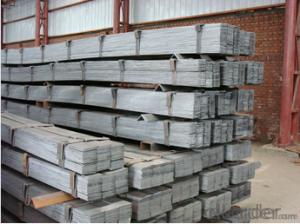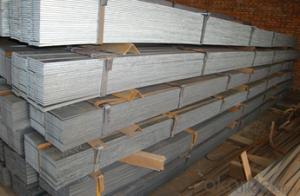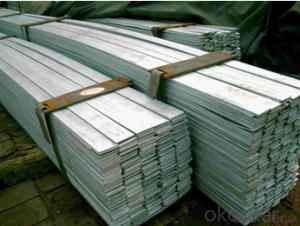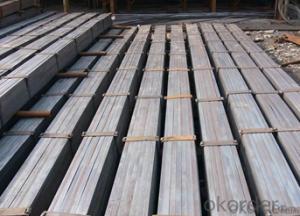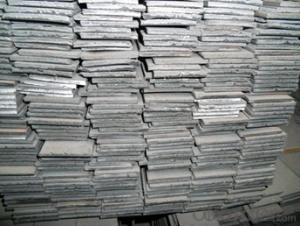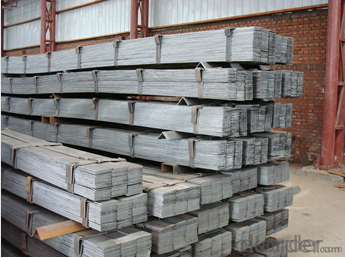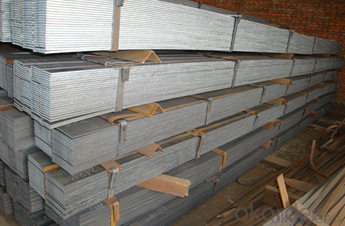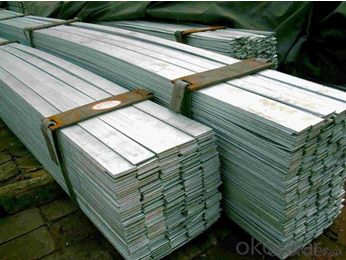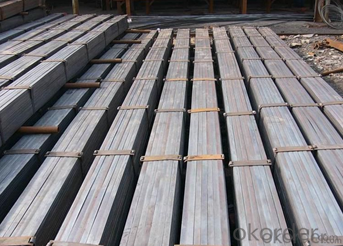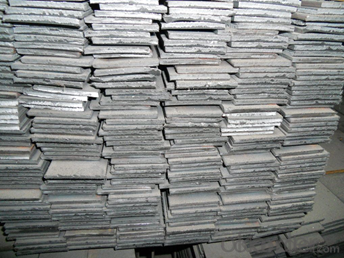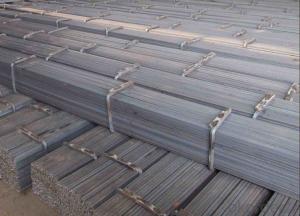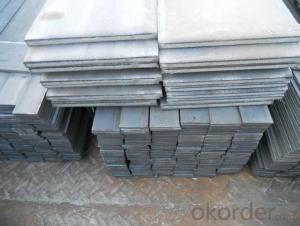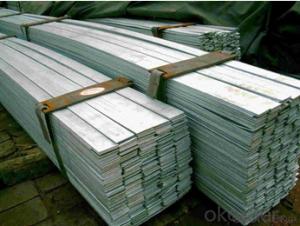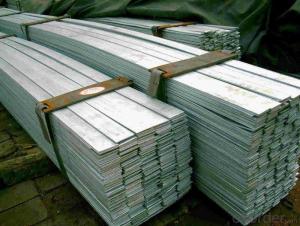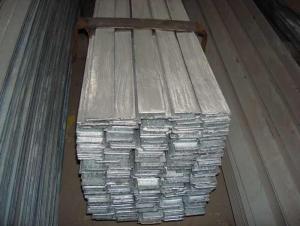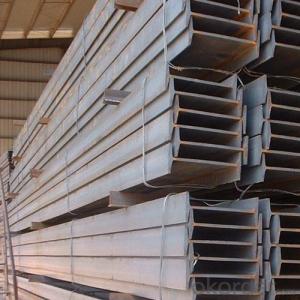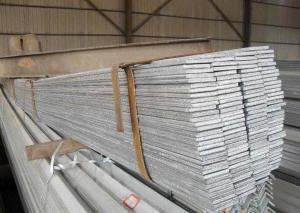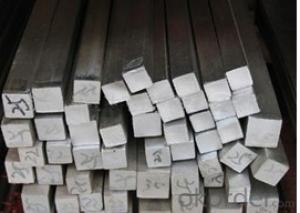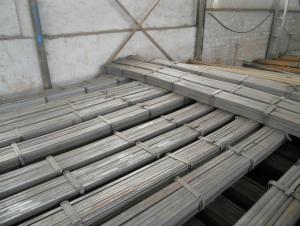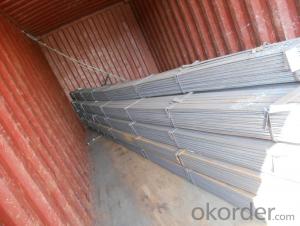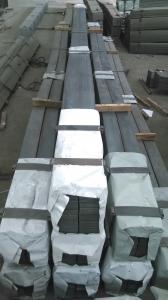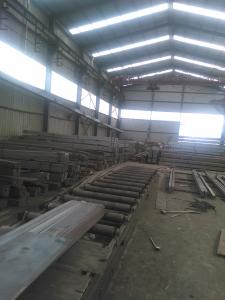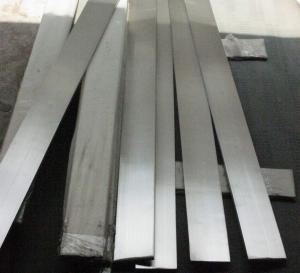Galvanized Flat Bar with Length: 6m, 12m
- Loading Port:
- Tianjin
- Payment Terms:
- TT OR LC
- Min Order Qty:
- 50 m.t.
- Supply Capability:
- 1000 m.t./month
OKorder Service Pledge
OKorder Financial Service
You Might Also Like
Product Description:
OKorder is offering Galvanized Flat Bar with Length: 6m, 12m at great prices with worldwide shipping. Our supplier is a world-class manufacturer of steel, with our products utilized the world over. OKorder annually supplies products to European, North American and Asian markets. We provide quotations within 24 hours of receiving an inquiry and guarantee competitive prices.
Product Applications:
Hot Rolled Steel I-Beams are ideal for structural applications and are widely used in the construction of buildings and bridges, and the manufacturing, petrochemical, and transportation industries.
Product Advantages:
OKorder's Galvanized Flat Bar are durable, strong, and resist corrosion.
Main Product Features:
Premium quality
Prompt delivery & seaworthy packing (30 days after receiving deposit)
Corrosion resistance
Can be recycled and reused
Mill test certification
Professional Service
Competitive pricing
Specifications of Galvanized Flat Bar
1. Invoicing on theoretical weight or actual weight as customer request
2. Length: 6m, 12m as following table
3. Sizes:
Galvanized Flat Bar Zinc Thickness:15-80μ
Grade: A36, SS400, Q235, Q195
Standard: ASTM, JIS, GB
Thickness:1.5mm-20mm
Width: 10mm-250mm
Width | Thickness | Width | Thickness | Width | Thickness |
(mm) | (mm) | (mm) | (mm) | (mm) | (mm) |
8 | 5-7 | 50 | 5-25 | 200 | 8-40 |
10 | 3-9 | 55 | 5-25 | 220 | 8-40 |
12 | 3-9 | 60 | 5-25 | 250 | 8-40 |
13 | 5-11 | 65 | 5-25 | 260 | 8-40 |
14 | 3-12 | 70 | 5-25 | 270 | 8-40 |
15 | 5-12 | 75 | 5-25 | 280 | 8-40 |
16 | 4-14 | 80 | 6-25 | 290 | 8-40 |
18 | 4-16 | 85 | 6-25 | 300 | 8-40 |
20 | 4-18 | 90 | 6-25 | 310 | 8-40 |
22 | 4-20 | 95 | 6-25 | 320 | 8-40 |
24 | 5-20 | 100 | 6-25 | 330 | 8-40 |
25 | 4-20 | 105 | 6-25 | 340 | 8-40 |
28 | 4-20 | 110 | 6-25 | 350 | 8-40 |
30 | 4-25 | 120 | 7-25 | 360 | 8-40 |
32 | 4-25 | 125 | 7-25 | 370 | 8-40 |
35 | 4-25 | 130 | 8-25 | 380 | 8-40 |
36 | 6-25 | 140 | 8-25 | 390 | 8-40 |
38 | 7-25 | 150 | 8-25 | 400 | 8-40 |
40 | 4-25 | 160 | 8-40 | ||
45 | 4-25 | 180 | 8-40 |
5. Material Specifications:
Production Standard: GB/T 700-2006 | |||||
Grade | Chemical composition (%,max) | ||||
C | Si | Mn | P | S | |
Q195 | 0.12 | 0.30 | 0.50 | 0.035 | 0.040 |
Q235A | 0.22 | 0.35 | 1.40 | 0.045 | 0.050 |
Q235B | 0.20 | 0.35 | 1.40 | 0.045 | 0.045 |
Q235C | 0.17 | 0.35 | 1.40 | 0.040 | 0.040 |
Q235D | 0.17 | 0.35 | 1.40 | 0.035 | 0.035 |
Q235 is similar to ASTMA36,JIS SS400
Usage & Applications of Galvanized Flat Bar
Widely used for construction,Fabrication , Ship building, Machinery manufacturing, Steel structure
Packaging & Delivery of Galvanized Flat Bar
1. Packing: it is nude packed in bundles by steel wire rod
2. Bundle weight: not more than 3.5MT for bulk vessel; less than 3 MT for container load
3. Marks:
Color marking: There will be color marking on both end of the bundle for the cargo delivered by bulk vessel. That makes it easily to distinguish at the destination port.
Tag mark: there will be tag mark tied up on the bundles. The information usually including supplier logo and name, product name, made inChina, shipping marks and other information request by the customer.
If loading by container the marking is not needed, but we will prepare it as customer request.
4. Transportation: the goods are delivered by truck from mill to loading port, the maximum quantity can be loaded is around 40MTs by each truck. If the order quantity cannot reach the full truck loaded, the transportation cost per ton will be little higher than full load.
5. Delivered by container or bulk vessel
Production flow of Galvanized Flat Bar
The process of hot-dip galvanizing results in a metallurgical bond between zinc and steel with a series of distinct iron-zinc alloys. The resulting coated steel can be used in much the same way as uncoated.
A typical hot-dip galvanizing line operates as follows:
Steel is cleaned using a caustic solution. This removes oil/grease, dirt, and paint.
The caustic cleaning solution is rinsed off.
The steel is pickled in an acidic solution to remove mill scale.
The pickling solution is rinsed off.
A flux, often zinc ammonium chloride is applied to the steel to inhibit oxidation of the cleaned surface upon exposure to air. The flux is allowed to dry on the steel and aids in the process of the liquid zinc wetting and adhering to the steel.
The steel is dipped into the molten zinc bath and held there until the temperature of the steel equilibrates with that of the bath.
The steel is cooled in a quench tank to reduce its temperature and inhibit undesirable reactions of the newly formed coating with the atmosphere.
FAQ:
Q1: Why buy Materials & Equipment from OKorder.com?
A1: All products offered byOKorder.com are carefully selected from China's most reliable manufacturing enterprises. Through its ISO certifications, OKorder.com adheres to the highest standards and a commitment to supply chain safety and customer satisfaction.
Q2: How do we guarantee the quality of our products?
A2: We have established an advanced quality management system which conducts strict quality tests at every step, from raw materials to the final product. At the same time, we provide extensive follow-up service assurances as required.
Q3: How soon can we receive the product after purchase?
A3: Within three days of placing an order, we will begin production. The specific shipping date is dependent upon international and government factors, but is typically 7 to 10 workdays.
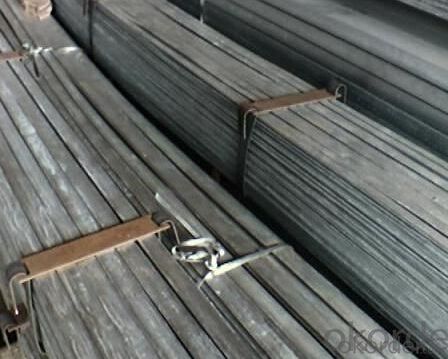
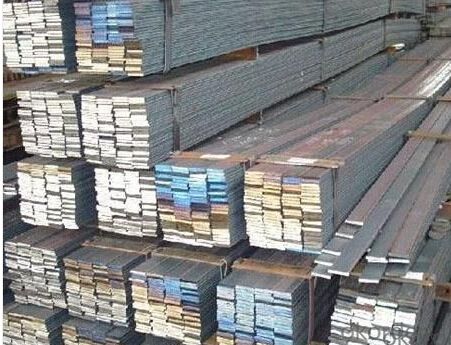
- Q: How is a steel flat bar manufactured?
- Hot rolling is the method used to manufacture a steel flat bar. This involves heating a large rectangular steel billet until it becomes malleable. The billet is then passed through a series of rolling mills where it is gradually compressed and shaped into a flat bar. To begin the manufacturing process of a steel flat bar, the steel billet must be prepared. Typically made of carbon steel, the billet is cast into a rectangular shape and then reheated in a furnace to a temperature that allows for easy shaping and manipulation. Once the billet has reached the desired temperature, it is fed into a series of rolling mills. These mills consist of rollers that gradually reduce the thickness and shape of the steel billet as it passes through. The billet is subjected to immense pressure from the rollers, causing it to elongate and take on the desired flat shape. As the billet passes through the rolling mills, it is cooled and lubricated to prevent overheating and excessive wear. Cooling methods such as water or air jets are used, while lubricants like oil or emulsions are applied to reduce friction and improve the surface finish. After undergoing several passes through the rolling mills, the steel billet is transformed into a flat bar with the desired dimensions. The bar is then cut to the required length and allowed to cool. Additional processes such as straightening, surface treatment, and quality inspection may be carried out before the bar is ready to be shipped or used in various applications. In summary, the manufacturing process of a steel flat bar involves heating the steel billet, passing it through rolling mills to shape and reduce its thickness, and then cutting and cooling the bar to its final dimensions. This process ensures that the steel flat bar possesses the necessary strength, durability, and surface finish required for its intended application.
- Q: How large is the flat steel used for equipotential grounding?
- 3.2.15 general equipotential connection with the sectional area of protective bonding conductors, shall not be less than the maximum protection of conductor size distribution line 1/2, protective bonding conductor cross-sectional area of the minimum and maximum value shall comply with the provisions of table 3.2.15.
- Q: How do steel flat bars contribute to the earthquake resistance of buildings?
- Steel flat bars contribute to the earthquake resistance of buildings by providing additional strength and stiffness to the structure. When used as reinforcements or bracing elements, they help distribute and absorb the forces generated during an earthquake, reducing the risk of structural failure. Additionally, steel flat bars enhance the overall stability of the building, minimizing deformation and improving its ability to withstand ground shaking.
- Q: Can steel flat bars be hardened or heat treated?
- Yes, steel flat bars can be hardened or heat treated, depending on the specific type of steel used. Heat treatment involves heating the steel to a specific temperature and then cooling it rapidly to achieve the desired level of hardness. This process can be used to increase the strength and durability of the steel flat bars. Hardening and heat treatment are commonly employed in various industries, such as construction, manufacturing, and automotive, to enhance the properties of steel flat bars and make them suitable for specific applications.
- Q: Do steel flat bars have a specific yield strength?
- Yes, steel flat bars have a specific yield strength. The yield strength of a steel flat bar refers to the amount of stress it can withstand before it starts to deform permanently. This property is typically specified by manufacturers and can vary depending on the type and grade of steel used.
- Q: Can steel flat bars be easily machined or drilled?
- Steel flat bars can indeed be easily machined or drilled. Steel is known for its excellent machinability, which means it can be easily shaped, cut, or drilled using various tools and techniques. Steel flat bars, being flat and uniform in shape, are particularly suitable for machining and drilling operations. They can be easily worked on using drills, milling machines, lathes, or any other equipment commonly used for metalworking. However, it is important to select appropriate cutting tools and speeds based on the specific grade and hardness of the steel being machined. Additionally, using appropriate coolant or lubrication during the machining process can help prolong tool life and improve the quality of the finished product.
- Q: How do you paint or coat steel flat bars?
- To paint or coat steel flat bars, you will need to follow a few steps. First, you need to prepare the surface of the steel. This involves removing any rust, dirt, or old paint using sandpaper, a wire brush, or a power tool such as a grinder. It is important to ensure that the surface is clean and smooth before proceeding. Next, you should apply a primer to the steel bars. The primer helps to create a bond between the steel and the paint or coating, improving adhesion and durability. Choose a primer specifically designed for metal surfaces and apply it evenly using a brush, roller, or spray gun. Make sure to follow the manufacturer's instructions regarding drying time and recommended number of coats. After the primer has dried, you can proceed to apply the paint or coating. Again, choose a paint or coating specifically made for metal surfaces. You can use a brush, roller, or spray gun to apply the paint, depending on your preference and the size of the flat bars. Apply multiple thin coats, allowing each coat to dry completely before applying the next. This helps to achieve a smooth and even finish. If you are using a coating instead of paint, make sure to follow the manufacturer's instructions regarding application and drying time. Some coatings may require curing at a specific temperature or may need a topcoat for added protection. After the paint or coating has dried completely, inspect the surface for any imperfections or areas that might need touch-ups. If necessary, lightly sand any rough spots and apply additional coats of paint or coating as needed. Remember to work in a well-ventilated area and wear appropriate safety gear, such as gloves and a mask, when painting or coating steel flat bars. Following these steps will help you achieve a professional and long-lasting finish on your steel flat bars.
- Q: Lightning protection grounding, what is called three surface welding?
- Lightning protection, grounding, the three sides of the welding:The buried depth of the grounding body shall not be less than 1m at the top, and the steel pipe grounding body shall be vertically configured.The length of the vertical grounding body shall not be less than 2.5m, and the spacing between them shall not be less than 5m.
- Q: What are the different types of steel alloys used in flat bars?
- There are several types of steel alloys used in flat bars, including carbon steel, stainless steel, tool steel, and alloy steel.
- Q: Can steel flat bars be drilled or machined?
- Yes, steel flat bars can be drilled or machined. Steel is a versatile material that can be easily drilled or machined to create various shapes and sizes for different applications.
Send your message to us
Galvanized Flat Bar with Length: 6m, 12m
- Loading Port:
- Tianjin
- Payment Terms:
- TT OR LC
- Min Order Qty:
- 50 m.t.
- Supply Capability:
- 1000 m.t./month
OKorder Service Pledge
OKorder Financial Service
Similar products
Hot products
Hot Searches
Related keywords
